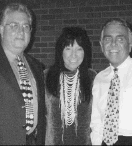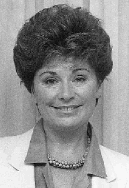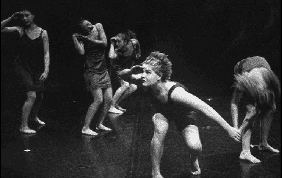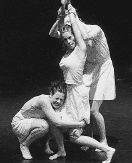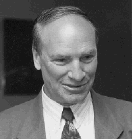
|

|
|
|
|
| | VOLUME 29, NUMBER 24 | WEDNESDAY, MARCH 17, 1999 | ISSN 1199-5246 | | |
|
|
||
|
|
Buffy Sainte Marie during her visit to York, pictured here with (left) Keith Lickers, education officer with the Ministry of Education and Training and (right) Ron Jamieson, senior vice-president for Aboriginal Banking, Bank of Montreal.
Singer, songwriter and Adjunct Professor of Music Buffy Sainte-Marie visited York University recently to explore a joint initiative in First Nations education between Faculties of Education and Environmental Studies at York, Native Studies at Trent University and the schools of the Six Nations First Nation. She was accompanied by Senior Vice-President of Aboriginal Banking, Bank of Montreal, Ron Jamieson, and Keith Lickers of the Ontario Ministry of Education and Training. Long before her distinguished career in music and acting, Sainte-Marie was a classroom teacher who has never abandoned her roots and interest in Native education. This has led to her full support and commitment to Project CradleBoard, a First Nations distance education and curriculum development project. Based on a partnership of U.S.-based reservation schools, interested teachers, cultural authorities and faculty members, CradleBoard developed with major funding from the Kellogg Foundation to include Cree, Ojibway, Menominee, Mohawk and Salish cultures. While visiting York, Sainte-Marie took the opportunity to meet with First Nations students from the Faculties of Environmental Studies and Education at McLaughlin College, which sponsored the event.
|
|
|
|
On Wednesday, February 24, 1999, a group of friends, colleagues, and former students met at the Scott Religious Centre to celebrate the life and times of Raffaella Maiguashca, an esteemed member of the Italian Section of the Department of Languages, Literatures and Linguistics, who passed away on January 14, 1999 after a two-year battle with lung cancer. Viola Stephens, one of the speakers, began the ceremony with the following lines from Bronwen Wallace:
Some people are a country
Many of us, including her loving family, Professor Emeritus Juan Maiguashca of the Department of History at York University, her children, Bice, Manuela and Carlos, have been plunged into that exile. Thankfully, we keep in our hearts and minds the memory of the daily living we shared with her and we carry with us, as beacons and guides, the invaluable lessons she taught us. The people who recalled their experiences with Raffaella included colleagues and friends at York University and at other institutions; some of these reminiscences covered a period of almost thirty years. From the Department of Languages, Literatures and Linguistics there were Viola Stephens, classical studies, Luisa Karumanchiri, Marina Frescura, and Rita Belladonna, Italian studies; from Victoria College at the University of Toronto, Anne Urbancic, Italian studies; and from Brock University, Anthony Mollica, professor of education, and president of editions Soleil Publishing. Two of her former students, Doris Calderan, a high school teacher, and Roberta Iannacito, a doctoral candidate in Italian studies at the University of Toronto, also shared their memories of a beloved teacher. Messages from persons who could not be present were read: from Professor Miguel Murmis, and Mrs. Gloria Murmis, Buenos Aires; Professor Judith Hellman, Mexico; and Professor Guy Allen, University of Toronto, Erindale. Raffaella was remembered not only for her deep commitment to her profession and to her students, her innovative scholarship and her work on joint projects, her love of language and her passion for excellence, but also for the personal qualities that endeared her to so many throughout her life. All who spoke expressed their deep sense of loss and their profound affection for a woman who touched their lives with her boundless warmth and incandescent vitality. Raffaella Maiguashca Raffaella Maiguashca enjoyed an active and creative academic life. She obtained her undergraduate degree in comparative literature at the University of Rome, Italy and an MA in Italian linguistics at the University of Toronto. Her professional life began in the Department of Italian at Cambridge University in England and continued in Canada where she taught both at York University and the University of Toronto. She published numerous articles and seminal language texts for learners of Italian as a second language and was the founder and coordinating editor of the York University Working Papers in Second Language Teaching. She served as a proactive member of the editorial boards of the Canadian Modern Language Review; ITALICA, the official journal of the American Association for Teachers of Italian (AATI); and the Italian Linguistics and Language Pedagogy series of the University of Toronto Press. She was also the Canadian representative of the AATI for many years and a member of the board of advisors of Centro Scuola e Cultura Italiana of Toronto and the University of Toronto Language Teaching Resource Unit. The publication for which she garnered considerable recognition is the Schede di lavoro, Volumes I & II which first appeared in 1985. This two-volume work, produced in collaboration with Marina Frescura, Luisa Karumanchiri and Jana Vizmuller-Zocco, revolutionized intermediate and advanced Italian language courses in North America. These texts are not only still in use in Canada and in the U.S., but have also been adopted in Italy for Italian as a Foreign Language. Before her illness, Raffaella was working on two other innovative projects. First, a textbook for advanced students of Italian on words, meaning and images in Italian, introducing figurative language through pedagogy, a project for which she had received a research development fellowship; second, a text on teaching lexical competence to teachers of Italian. She had already presented and published numerous aspects of these works and was close to completing the first volume. All of Raffaella's academic activities were governed by the thought that linguistic theory and pedagogical practice should enlighten and reinvigorate each other. This perspective enlivened her considerable accomplishments as a teacher which were duly recognized in 1987 when she won the York University, Faculty of Arts, Outstanding Teaching Award and the Ontario Colleges and Universities Faculty Association Teaching Award. Quoting a comment made by several students, the presenter of this last award said: "When Raffaella teaches, even the walls learn." Her reputation as a teacher was international. She was invited to give courses and lectures at universities in both Italy and the U.S., in particular, at the Italian Summer School at Middlebury College, and at the Universita' per Stranieri of Siena and Perugia. Raffaella was an exceptionally vibrant, caring person who lived her life according to the maxim that we can do no great things, just small things with great love. This outlook allowed her quietly to accomplish a great many things and to make lifelong friends. She will be greatly missed.
|
|
|
|
York University dancers share the stage this week with visiting performers from Osaka University, Japan and with Montreal's Concordia University, at the annual Festival of New Choreography. Festival artistic director, Holly Small, has selected more than two dozen dance works by students, faculty and guest choreographers, including: York dance faculty member Darcey Callison who premieres his ensemble piece for 27 dancers set to music by Phillip Glass, David Bowie and Brian Eno. Titling the piece, "Ever Falling Home", Callison conceives the dance as images of a tribe of women in stages of going, coming and waiting. In collaboration with musician Lorne Lampert, who performs on stage using shakers, a claypot and a drum, Julie Brunet has created a piece for two dancers based on the earth's elements and how its texture evokes sounds and movement. Lisa Ryan, an exchange student form England's Chichester University, has choreographed an intriguing piece for seven dancers titled "Cold Water Heating Supply", in which the soloist awakes from a catatonic state to find herself in an underground wasteland along with her cold, obliviously oppressed companions.
"I see all round me apathetic people with no zip or spark of life," says Ryan. "Cold Water Heating Supply" is a kind of metaphor for a journey. One dancer wakes up and slowly sees what's happening. As she struggles to fight her way out, she dislodges some of the other clogged people. I think it is a hopeful work because they can see light at the end of that cold water pipe." The visiting dancers from Osaka University of Health and Sport Sciences present two high-energy dance pieces with the evocative names "The Pale Night Desert" and "To the Open Sea", which blend western modern dance with a traditional Japanese flavour. The guest artists from the Department of Contemporary Dance at Montreal's Concordia University have selected two highly entertaining works: JoDee Allen has choreographed a sensual and lyrical piece "Sur Face Intact" and Eva Asselin delights audiences with her fun-filled duet, "The Unbearable Lightness of Choosing". The York Dance Ensemble performs "Pinpoints" by faculty member Susan Cash and the playful "Engaging the Source" by ensemble member Monique Harris, a fourth year student, who this year has concentrated on choreographing and stage managing the ensemble. Harris also presents the premiere of "Scrambles", a mischievous and thought-provoking work revolving around the numbers one to five, each of whom have their own concerns. "Number three hates being number three," says Harris, "and number four wants to be number one. Eventually they all learn to come to terms with their lot in life." The Festival of New Choreography is the last opportunity for admirers to see choreographer Motaz Kabbani's solo work, "With-In-finity", which York professor Donna Krasnow has performed across Canada and the U.S. "With-In-finity" is a journey through the realms of destiny, dream, destruction, death, despair, delirium and desire, set to excerpts from J.S. Bach's Goldberg Variations. The show runs in a four part series from March 16 to 19, at 5:30 and 7:30 p.m. The entire series runs on Saturday, March 20 starting at 1 p.m. Performances take place in Burton Auditorium, and admission is $5 per show. Tickets are available at the door or may be reserved in advance by calling the York Dance Department hotline, (416) 650-8030. |
|
|
|
Gordon Shepherd, distinguished research professor of Earth and Atmospheric Science, and director of CRESSTech York University Distinguished Research Professor Gordon Shepherd has been elected a Fellow of the American Geophysical Union (AGU). This prestigious honour is given to only 0.1 per cent of the AGU membership. Shepherd, who is with York's Department of Earth and Atmospheric Science and is director of CRESSTech, received the fellowship for pioneering new concepts in interferometric spectroscopy and leadership in the utilization of atmospheric radiation for the determination of the structure, composition and dynamics of the atmosphere. The AGU is an international scientific society of 35,000 members dedicated to advancing the understanding of Earth and its environment in space, and making the results available to the public. It publishes more than 50,000 pages annually in some 200 journal issues, as well as more than a dozen books. |
|
|
|
At a joint meeting, held on January 14, 1999, the executive committees of the Board of Governors and the Senate agreed to recommend to their respective bodies that they endorse the new York University mission statement. It was endorsed by the Senate at its meeting on January 28, and by the Board of Governors on February 22, 1999. These endorsements validated a shared vision of the University's mission and values as it completes its 40th year and prepares for the challenges and opportunities of the future. The mission statement is intended to provide a sense of common direction and aspiration for the University's governing bodies and for all members, alumni and friends of York.
YORK UNIVERSITY
The mission of York University is the pursuit, preservation, and dissemination of knowledge. We promise excellence in research and teaching in pure, applied and professional fields. We test the boundaries and structures of knowledge. We cultivate the critical intellect. York University is part of Toronto: we are dynamic, metropolitan and multi-cultural. York University is part of Canada: we encourage bilingual study, we value tolerance and diversity. York University is open to the world: we explore global concerns. A community of faculty, students and staff committed to academic freedom, social justice, accessible education, and collegial self-governance, York University makes innovation its tradition. Tentanda Via: the way must be tried.
UNIVERSITÉ YORK
L'Université York a pour mandat d'accroître, de préserver et de diffuser le savoir. Nous nous engageons à ce que la recherche et L'Université York partage avec la métropole de Toronto son caractère dynamique et multiculturel. L'Université York partage avec le Canada son encouragement aux études bilinques, son attachement à la tolérance et à la diversité. L'Université York s'ouvre sur le monde et s'interroge sur les grandes préoccupations internationales. Composée d'enseignants, d'étudiants et de membres du personnel dévoués à la cause de la liberté, de la justice sociale, du libre accès à l'enseignement et la direction démocratique, l'Université York a fait de i'innovation sa tradition. Tentanda Via: Ouvrir des voies nouvelles.
|
|
|
|
Author Alvin Abram tells stories: stories that defy logical explanations, stories of chance and circumstance, stories that he calls "miracles of fate". Abram was a recent guest of the Jewish Student Federation, where he related vignettes of Holocaust survivor experiences, not always during the war, but many in Toronto. His book, The Light After the Dark, Key Porter Books, is now in its third printing and tells some remarkable stories: of a woman who found her brother because of a coat, of five gold watches that led to why a woman was not hung, and of another who returned to her homeland almost 50 years after the war to find her brother only to discover he lived ten kilometres from her. The audience listened raptly as Abram described the stories of many survivors, one, who at the age of ten, was buried alive with 10,000 Jews, escaped and lived to fight the invaders of his country. In 1990 this man went to Israel for the first time to see a surviving uncle and his past came back to meet him at the Wall. Another escaped from Warsaw to Russia in 1939, then emigrated to Israel where he fought in three wars. While fighting for the liberation of Jerusalem in 1967 he had a vision: to create a piece of art that would tell the history of the Jews from Abraham to the birth of Israel. He came to Canada in 1974, and after 13 years finished a 38 foot mural that was displayed nationally. Faigie Libman, a Holocaust survivor was a guest of Abram at the lecture. Her story too is told in the book. The Light After the Dark is available at the York University Book Store and at book stores across Canada. Royalties go to The Jewish National Fund, Shoah (Spielberg Foundation) and The March of the Living. |
|
|
|
|
|
|
| Current Issue | Previous Month | Past Issues | Rate Card | Contact Information | Search |
|
